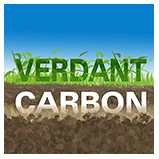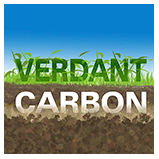|
Carbon is present in the soil as organic carbon (plants, bugs, and microbes) and inorganic carbon (rocks such as chalk). Numerous soil functions and ecosystem services depend on soil organic carbon (SOC). Improvements in soil health, along with increase in availability of water and nutrients, increases soil’s resilience against extreme climate change events and lends to disease-suppressive attributes [1], [2]. Carbon bonds within soil organic matter are the main determinants of biological activity because they provide the primary energy sources for living soil organisms [3]. The biological activity that is generated from this has a major influence on the physical and chemical properties of soil. Soil aggregation and stability of soil structure increases with increasing organic carbon. In turn, these factors increase the infiltration rate and available water holding capacity of the soil [4].
Soil carbon is also a food source for micro-organisms and an important bacteria metabolite, where microbial activity plays a key role in improving soil structure. Improved soil structure increases water infiltration and increases water holding capacity of the soil. High levels of organic carbon help to maintain agricultural production through its role in maintaining soil health, raising fertility, and reducing erosion. Soil organic carbon therefore represents an important indicator for soil quality, for both agricultural functions and for environmental functions; with sequestration of carbon being an imperative way to mitigate climate change by reducing atmospheric carbon dioxide. On the Farm level, the presence (and increase) of soil carbon changes the structure of soils over time; providing increased resilience to physical degradation; slowing and storing water (to the benefit of plant life during drier spells); and creating space for beneficial microbes, such as fungi and bacteria, which provide nutrients through their processing of organic matter. High SOC in mineral soils, is usually associated with higher biological productivity with positive implications for both, crop yields and local wildlife habitats [5]. Therefore, measuring and monitoring SOC levels can lead to a better understanding of the farm’s soil health, environmental impact, and the health of the landscape it is a part of. Measuring SOC as a response to changes in on-site activities can give you a vital insight into several important metrics and can help you to assess whether such activities will be useful going forward. Citations: [1] Lal, R. (2016) ‘Soil Health and Carbon Management’, Food and Energy Security, 5(4), pp. 212–222. doi:10.1002/fes3.96. [2] Singh, B.K. et al. (2023) ‘Climate change impacts on plant pathogens, food security and paths forward’, Nature Reviews Microbiology, 21(10), pp. 640–656. doi:10.1038/s41579-023-00900-7. [3] Jones, D. (2010) ‘Soil quality and biofuel production. by R. Lal and B. A. Stewart. Boca Raton FL, USA: CRC Press (2010), pp. 201. ISBN 978-1-4398-0073-7.’, Experimental Agriculture, 46(4), pp. 564–564. doi:10.1017/s0014479710000463. [4] Reicosky, D.C. (2003) ‘Conservation Agriculture: Global Environmental Benefits of soil carbon management’, Conservation Agriculture, pp. 3–12. doi:10.1007/978-94-017-1143-2_1. [5] Lal, R. (2020) ‘Soil Organic Matter Content and crop yield’, Journal of Soil and Water Conservation, 75(2). doi:10.2489/jswc.75.2.27a.
0 Comments
Soil carbon is the solid carbon stored in global soils; existing in organic and inorganic forms and is the key component of a soil’s ‘health’, affecting the soil’s chemical, physical and biological properties [1].
Soil organic carbon (SOC) refers only to the carbon component of organic compounds and constitutes the largest carbon stock in terrestrial ecosystems and is considered a fundamental building block of life. It is introduced into soils through decay, and processing by a soil microbiome evolved to make use of all the nutrients contained within it. Soil inorganic carbon (SIC), however, consists of mineral forms of carbon, either from weathering of parent material, or from the reaction of soil minerals with atmospheric CO2 [2]. SIC is often considered more securely sequestered in soils, than SOC, which will wax and wane with the seasons, hopefully in an upward trend. However, the processes that increase SIC happen far below the surface and are dependent on factors harder to directly manage such as precipitation rates and weathering of bedrock [3]. On the other hand, for SOC, we are seeing numerous farming practices (such as cover cropping and mob grazing), being deployed to improve the levels of SOC. Soil carbon is also a fundamental component of soil organic matter (SOM), and commonly recognized as one of the key parameters of soil quality [4], with SOC often considered an important indicator of soil health. The quantity and quality of SOC are linked to vital soil functions including nutrient mineralization, permeability to air, water infiltration, and flood control. Citations: [1] Rice, C.W. (2005) ‘Carbon cycle in Soils | Dynamics and management’, Encyclopedia of Soils in the Environment, pp. 164–170. doi:10.1016/b0-12-348530-4/00183-1. [2] Lorenz, K. and Lal, R. (2018) ‘Soil Carbon Stock’, Carbon Sequestration in Agricultural Ecosystems, pp. 39–136. doi:10.1007/978-3-319-92318-5_2. [3] Ferdush, J. and Paul, V. (2021) ‘A review on the possible factors influencing soil inorganic carbon under elevated CO2’, CATENA, 204, p. 105434. doi:10.1016/j.catena.2021.105434. [4] Blanco, J.A. (2017) ‘Managing Forest Soils for Carbon Sequestration: Insights From Modeling Forests Around the Globe’, Soil Management and Climate Change [Preprint]. doi:10.1016/b978-0-12-812128-3.00016-1. |
AuthorFrank Gollins. To help provide an understanding of the science behind soil, we have written some essays, addressing some FAQs, and how/why we do what we do.
ArchivesCategories |
|
Vertical Divider
|
Verdant Carbon Limited
Greenfields, Pested Lane, Challock, Ashford Kent TN25 4BD Telephone : 07732 476 447 Registered in England and Wales, Company number: 13610537 VAT number: GB393249470 Registered office: Vine Hall Farm, Bethersden, Ashford, England, TN26 3JY |
Verdant Carbon Limited
Greenfields, Pested Lane, Challock, Ashford Kent TN25 4BD
Telephone : 07732 476 447
Registered in England and Wales, Company number: 13610537 VAT number: GB393249470
Registered office: Vine Hall Farm, Bethersden, Ashford, England, TN26 3JY
© Content Copyright to Verdant Carbon 2021
Telephone : 07732 476 447
Registered in England and Wales, Company number: 13610537 VAT number: GB393249470
Registered office: Vine Hall Farm, Bethersden, Ashford, England, TN26 3JY
© Content Copyright to Verdant Carbon 2021
Website by Greg Bottle

 RSS Feed
RSS Feed

